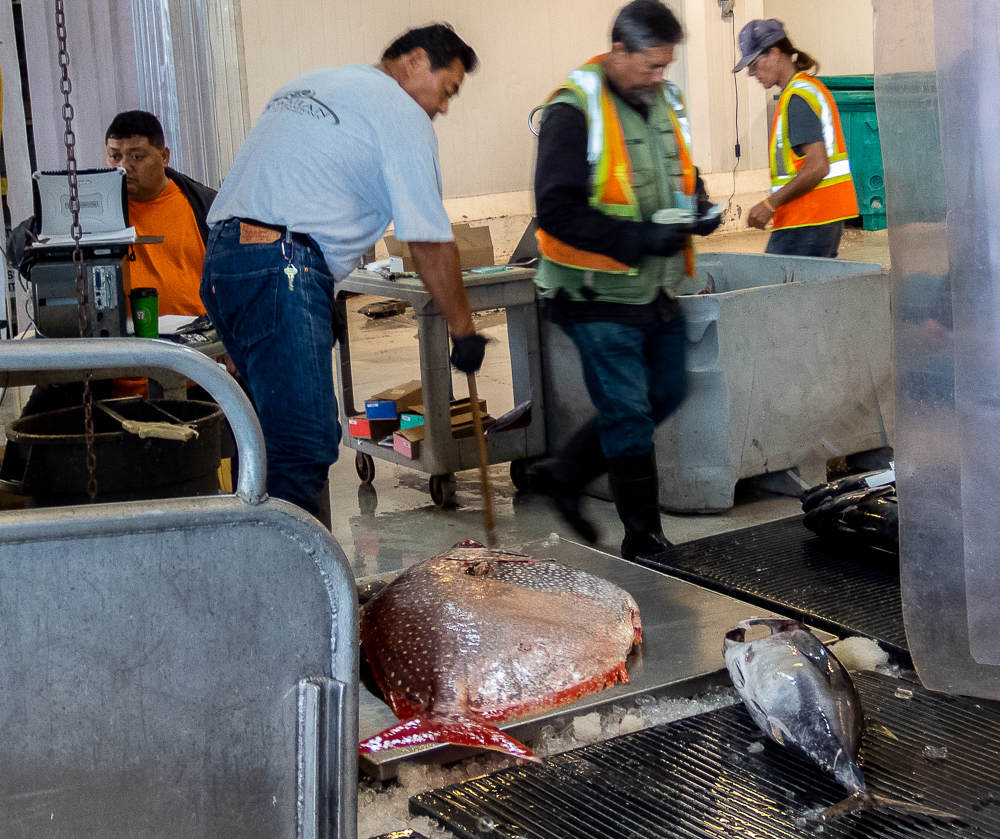Look out Charlie, your more glamorous sister, Ahi, is taking over! The Honolulu Fish Auction was the perfect place to meet her and learn all about maximum traceability as Hawaii leads the charge to understand the tons of fish consumed and sold in the state. We were there with Chef Debbie Thomas of Dinner is Served RI (with her own seafood background infused by her home state of Rhode Island) to learn everything we could about the fish she was going to be serving for a select dinner that evening.

Nico’s Market sells fresh-from-the-boat ahi through a shop on Pier 38 in Honolulu directly adjacent to the auction. It doesn’t get much fresher than buying it off the docks. For the catch-of-the-day you should plan to hit the fish markets before noon recognizing that today’s catch is generally out of the auction by 9 AM.
The auction kicks off well before dawn when the fishing fleet pulls in and unloads all their catch from iced hulls directly into the climate-controlled warehouse beginning at 1 AM. The first step is to be rinsed off before being weighed on a scale capable of up to 2000 lbs. Most ahi tuna come in between 500-1000 lbs so watching them be slid onto the scale by one man is impressive. As they are weighed a barcode tag is created indicating the ship, captain, type of fish, weight and, for larger fish (like swordfish), how many pieces it was sawed into which is immediately stapled onto the fish fin making all details visible to the buyers.


Huge flatbed trolleys move the catch into the sales room where a small chunk and slice are quickly cut from near the tail and placed on top for the buyers to review. Another staff member pokes a six-inch sample plug to show the color depth which helps buyers grade the quality of the fish. Buyers wander through the large warehouse holding slices up to the light or testing consistency and fat content of the chunk between their fingers before bidding in the fast-moving auction. As the first whistle blows at 5:30 AM, the auctioneer sells each fish throwing down a tag along with the buyer’s tag before the entire group moves onto the next flatbed.

After auction workers scan the fish barcode into a computer entering the price per pound and print a final price tag, buyer representatives gather their fish moving them around on empty flatbeds in a ballet of carts worthy of the Joffrey for intricacy and spatial awareness. One wouldn’t want to get in the way as new and old fish make their way into and out of the sales cooler. Almost as quickly as they arrived, fish are out the door to waiting giant insulated trolleys filled from the ice house next door. Some industrial buyers bring refrigerated trucks to roll their giant purchases into while smaller operations might just toss a 250 pounder into the back of a waiting SUV. Unlike most fish auctions around the world, this one is open to the public allowing anyone to purchase fish by signing in for a personal tag at the main entry. We met a gentleman who comes together with some buddies to purchase one large tuna a month at around $5 per pound to turn into $25 per pound ahi jerky.
Over the course of an average day the auction sells 90,000 pounds of fresh fish directly into the marketplace making this one of the most active fish auctions in the world and the only significant one between Tokyo and New York. The Honolulu Fish Auction offers weekly tours to see how your dinner gets from hook-to-plate and learn about quality standards and sustainable practices the industry is pioneering.
For Nico’s Pier 38 Market and Restaurant, http://nicospier38.com/
For the Honolulu Fish Auction details and tours, https://www.hawaii-seafood.org/
Check out our Ahi Journey – Part 2 – The Farmer’s Market as we watch
Chef Debbie Thomas search for complementary ingredients to the ahi.

